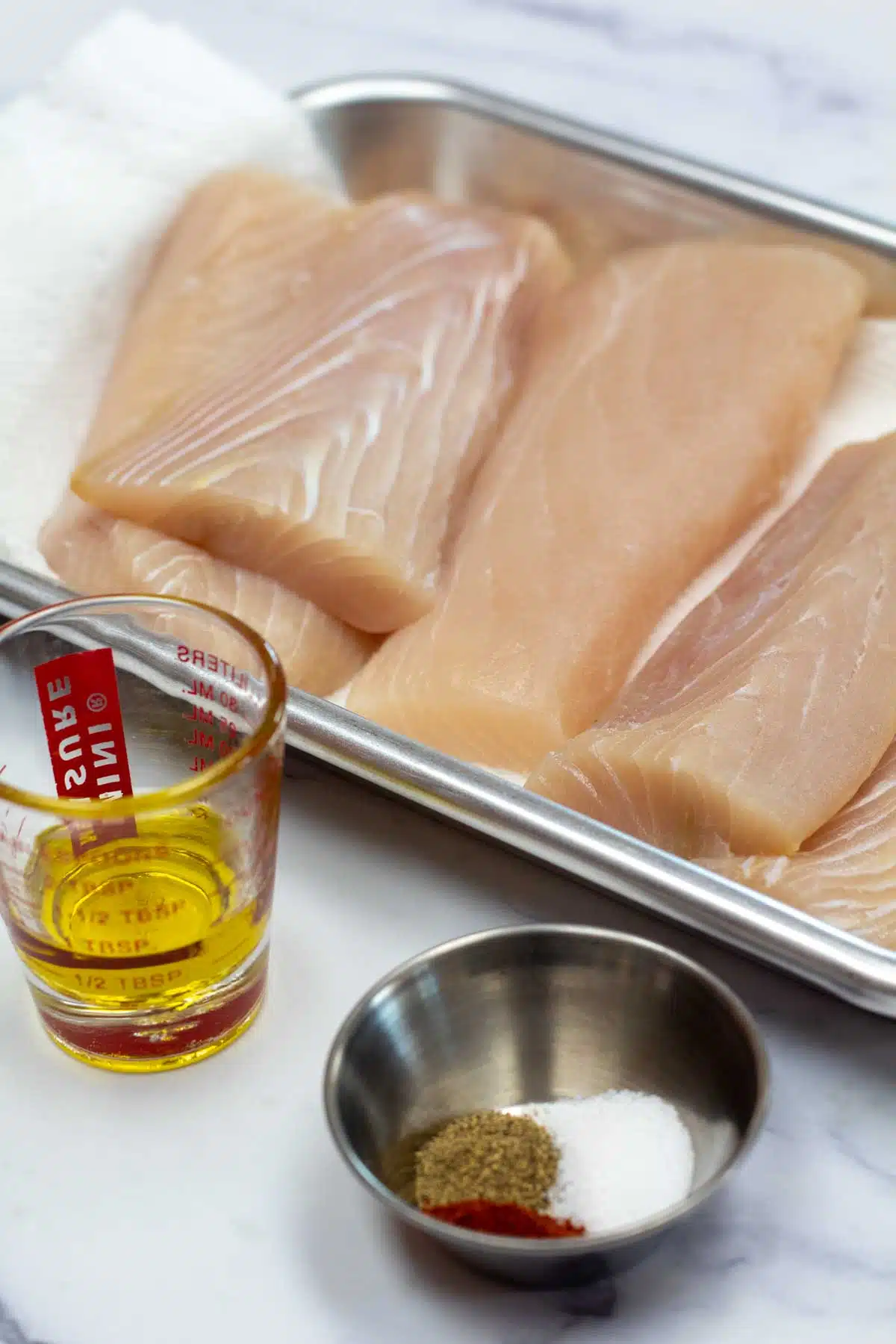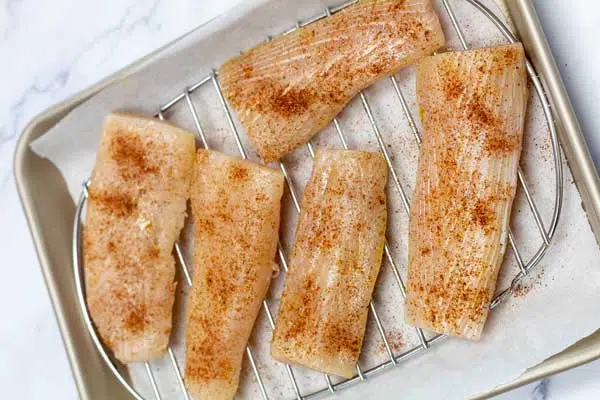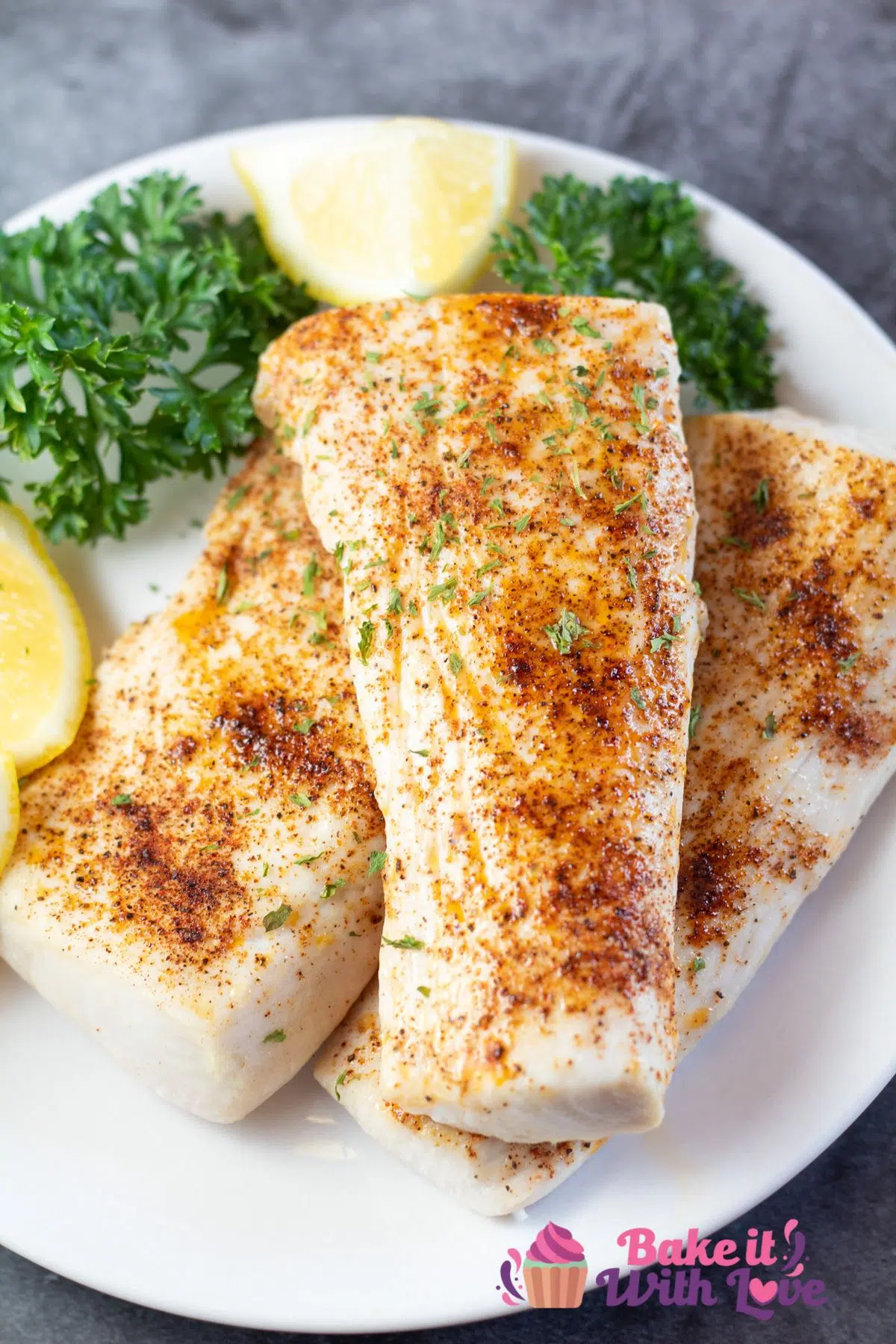Broiled mahi mahi is a super quick and effortless way to make a wonderfully delicious seafood dinner in less than 10 minutes! This method always results in tasty fish that are tender and moist. Serve it alongside some lemon sauce for a meal that everyone will love.

Jump to:
Mahi mahi is a subtropical whitefish with a mild and sweet flavor. It is an incredibly popular fish option for many different recipes.
This broiled mahi mahi will be ready to enjoy in a matter of minutes, plus it is easy to whip up on short notice. This will become one of your new last-minute staple dishes.
If you want to learn more about this tasty fish, check out my post all about mahi mahi!
🥘 Ingredients
When selecting some fresh mahi mahi, make sure to choose fillets that are moist and shiny, these filets are fresh and delicious.

- Mahi Mahi - 24 ounces of mahi mahi fillets. Fresh is best, but you can use frozen fillets that have been fully thawed!
- Olive Oil - 1 tablespoon of extra virgin olive oil (EVOO).
- Salt - ½ teaspoon of salt to make all of the flavors stand out.
- Paprika - ½ teaspoon of paprika to add a great flavor and beautiful color.
- Pepper - ¼ teaspoon of pepper.
- Lemon - 1 lemon that has been sliced or cut into wedges, for garnish.
Be sure to see the free printable recipe card below for ingredients, exact amounts & instructions with tips!
🔪 How To Broil Mahi Mahi
Make sure to keep an eye on your fish while it is under the broiler, you don't want to accidentally overcook it. Grab your broiler pan, basting brush, and measuring spoons to get this tasty seafood dinner cooking!
In only 10 minutes, you'll have 4 delicious servings of broiled mahi mahi ready to enjoy.

- Prepare and preheat. To get started, preheat your broiler. Line a broiler pan or baking sheet with aluminum foil or parchment paper (that has been trimmed to prevent burning) and lightly grease the rack. Once readied, place the rack into the broiler pan or baking sheet.
- Season the fish. Arrange the 24 ounces (approximately 4-6 filets) of mahi mahi fillets into a single layer on the rack, brush them with 1 tablespoon of extra virgin olive oil, and sprinkle with ½ teaspoon of salt, ¼ teaspoon of pepper, and ½ teaspoon of paprika.
- Broil. Place the broiler pan onto the 2nd rack of your oven and broil the fish for approximately 8 minutes, or until it easily flakes with a fork.
- Serve. Remove the fish from the oven and serve immediately with lemon slices.
Serve with my tasty drawn butter, some lemon butter sauce for fish, or a spicier pick like Bloves seafood sauce. Add a side of Greek pasta salad for a tasty meal. Enjoy!

>>>See All Of My Tasty Recipes Here!<<<
💭 Angela's Pro Tips & Recipe Notes
- According to the USDA, all fish should be cooked to a minimum internal temperature of 145°F (63°C). However, most people feel this is overcooked. Use your best judgement when serving your mahi mahi.
- Leftover mahi mahi also tastes delicious cold! You can flake it onto some salad or use it in a sandwich.
- To store: Place any leftovers in a sealed container in the fridge for up to 4 days.
- To reheat: Splash a tiny bit of water onto your fish and wrap it in foil. Bake it in the oven at 275°F (135°C) for 10-15 minutes.
❓ Recipe FAQs
To be specific, mahi mahi is done when it has reached an internal temperature of 137°F (58°C). Additionally, if you poke a fork into the thickest part of the fish and push it up, the meat should easily flake.
If your fish has a chewy texture, it was probably overcooked. When overcooked, the mahi mahi will shrink, firm up, and dry out. Make sure to keep an eye on your fish while cooking so that you don't overcook it!
Mahi mahi skin is tough and chewy. Typically, it is removed from the fish before cooking, unless you will be grilling or broiling it.
If left on, you can remove the skin after it is cooked, before serving. Either way, it is personal preference as to when (or if) you want to remove the skin.

🐟 Other Mahi Mahi & Fish Recipes
- Grilled Mahi Mahi
- Pan Seared Mahi Mahi
- Baked Mahi Mahi
- Grilled Jamaican Jerk Red Snapper
- Grilled Branzino
- Baked Monkfish
Do you love a recipe you tried? Please leave a 5-star 🌟rating in the recipe card below and/or a review in the comments section further down the page.
Stay in touch with me through social media @ Pinterest, Facebook, Instagram, or Twitter! Subscribe to the newsletter today (no spam, I promise)! Don't forget to tag me when you try one of my recipes!
📖 Recipe Card
Broiled Mahi Mahi
Ingredients
- 24 oz mahi mahi fillets
- 1 tablespoon olive oil
- ½ teaspoon salt
- ½ teaspoon paprika
- ¼ teaspoon pepper
- lemon slices (sliced, or wedges)
(Note: 2x or 3x only changes the ingredient list)
Instructions
- To get started, preheat your broiler. Line a broiler pan or baking sheet with aluminum foil or parchment paper (that has been trimmed to prevent burning) and lightly grease the rack. Then, place the rack into the broiler pan or baking sheet.
- Arrange the 24 oz mahi mahi fillets into a single layer on the rack, brush them with extra virgin 1 tablespoon olive oil, and sprinkle with ½ teaspoon salt, ¼ teaspoon pepper, and ½ teaspoon paprika.
- Next, place the broiler pan onto the 2nd rack of your oven and broil the fish for approximately 8 minutes, or until it easily flakes with a fork.
- Remove the fish from the oven and serve immediately with lemon slices.
Notes
- According to the USDA, all fish should be cooked to a minimum internal temperature of 145°F (63°C). However, most people feel this is overcooked. Use your best judgement when serving your mahi mahi.
- Leftover mahi mahi also tastes delicious cold! You can flake it onto some salad or use it in a sandwich.
- To store: Place any leftovers in a sealed container in the fridge for up to 4 days.
- To reheat: Splash a tiny bit of water onto your fish and wrap it in foil. Bake it in the oven at 275°F (135°C) for 10-15 minutes.



Lara M says
This was absolutely fantastic! I don’t remember how long it took to cook, because I used a probe thermometer. The flavoring was perfect.
Anonymous says
Do you broil skin side down or skin side up
Angela @ BakeItWithLove.com says
Skin side down, I have the meat seasoned and facing upward. Thanks for asking!